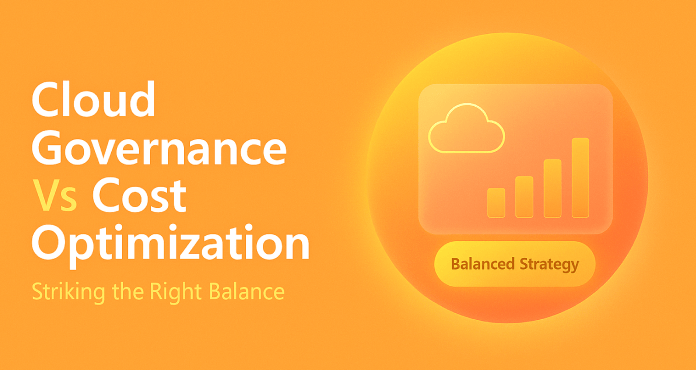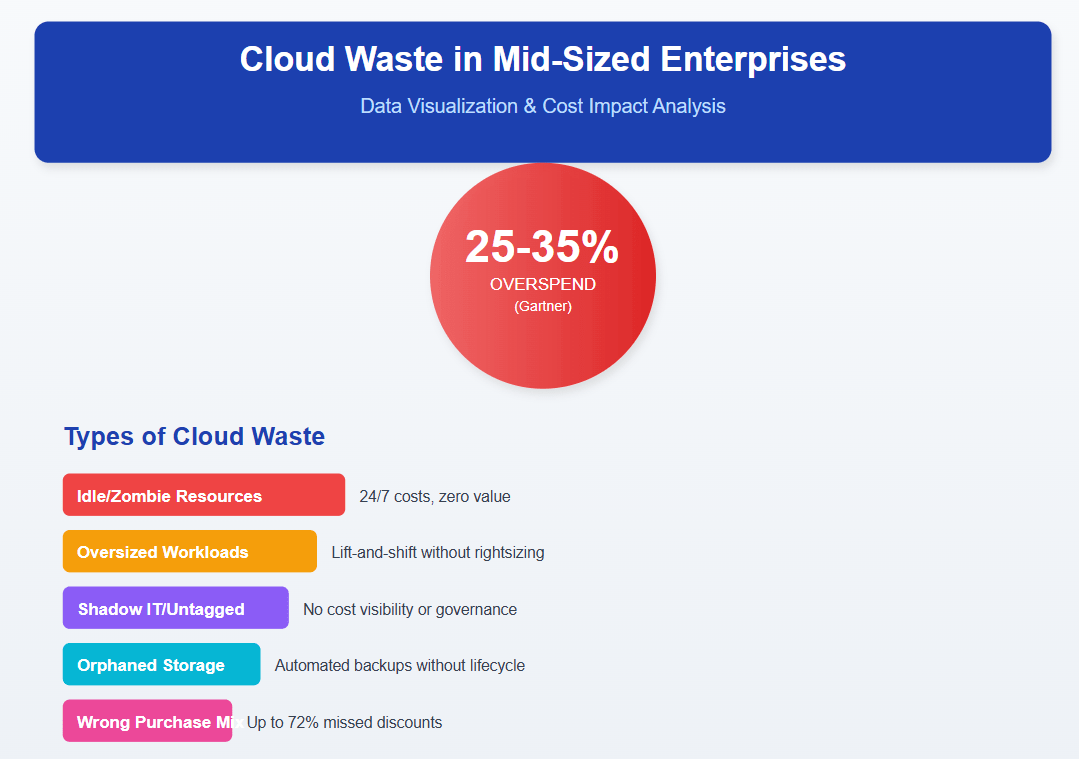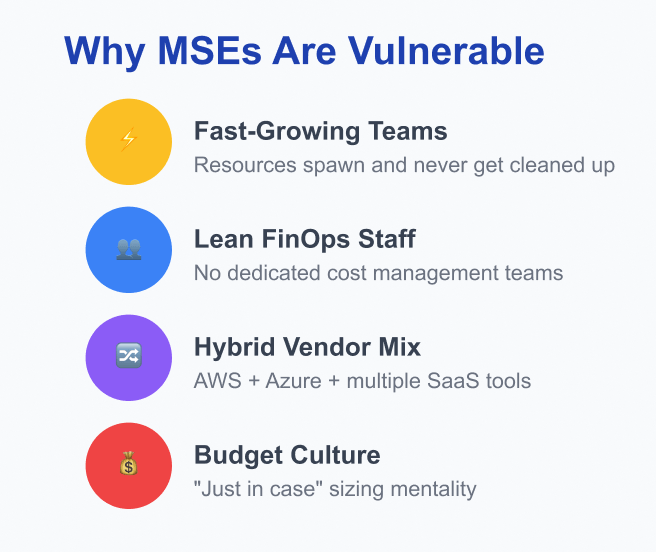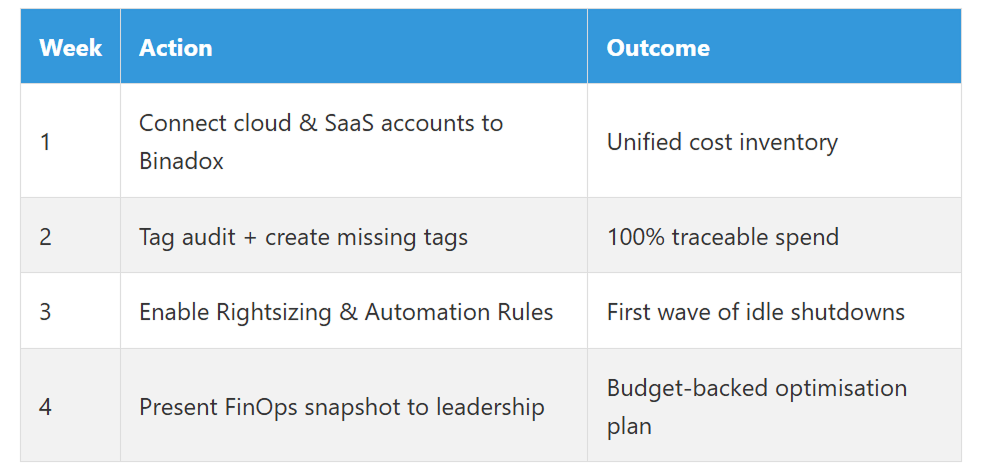
The promise of cloud computing is irresistible for mid-sized enterprises (MSEs): instant scalability, pay-as-you-go pricing, and freedom from on-prem hardware. Yet many organisations discover a different reality on their invoices—”cloud waste.” Gartner estimates that companies overspend 25-35% of their cloud budget on resources they never truly use.

The situation has become more complex as digital transformation accelerated post-2020. Mid-sized enterprises, caught between startup agility and enterprise-grade governance, often find themselves in a perfect storm of cloud cost inefficiency. The rapid adoption of remote work, increased reliance on SaaS applications, and the pressure to scale quickly have created an environment where cloud spending can spiral out of control.
Unlike large enterprises with dedicated FinOps teams and sophisticated cost management practices, MSEs typically operate with leaner IT departments and less mature financial oversight of cloud resources. This creates blind spots that can cost organizations hundreds of thousands of dollars annually—money that could otherwise fuel growth, innovation, and competitive advantage.

1. What Exactly Is Cloud Waste?
Cloud waste encompasses any cloud spending that doesn’t deliver proportional business value. It’s not just about unused resources—it’s about the mismatch between what you’re paying for and what you’re actually utilizing. Understanding the different types of waste is crucial for developing an effective elimination strategy.
| Type of Waste | Typical Triggers in MSEs | Hidden Impact |
| Idle or Zombie Resources | QA instances left running after a sprint; abandoned dev VMs | Pays for compute/network/storage 24×7 while producing zero value |
| Oversized Workloads | Lift-and-shift from on-prem without rightsizing | Higher hourly rates + unnecessary reserved-instance commitments |
| Shadow IT / Untagged Assets | Teams swipe cards for SaaS or spin up personal AWS accounts | Finance can’t trace cost drivers; governance & security risks |
| Orphaned Storage & Snapshots | Automated backups without lifecycle rules | Compounding GB charges every month |
| Mis-aligned Purchase Options | Buying on-demand where savings plans or RIs fit, or vice-versa | Missed discounts up to 72% |
Real-World Example:
A 200-employee software company discovered they were spending $8,000 monthly on development environments that ran 24/7, including weekends. By implementing automated shutdown schedules, they reduced this cost by 65% while maintaining full development productivity.
2. Why Mid-Sized Enterprises Are Especially Vulnerable
Mid-sized enterprises occupy a unique position in the market that makes them particularly susceptible to cloud waste. They’ve outgrown the simplicity of small business solutions but haven’t yet developed the sophisticated governance structures of large enterprises.
Fast-Growing Teams – New projects spawn clouds of short-lived resources that never get cleaned up. In the rush to meet deadlines and deliver features, development teams often provision resources with the intention of cleaning them up later—but “later” rarely comes. The faster an MSE grows, the more likely these forgotten resources accumulate.
Lean FinOps Staff – MSEs rarely have a full FinOps squad; cloud bills remain a black box. While large enterprises employ dedicated cloud financial management teams, MSEs typically have one or two IT professionals juggling multiple responsibilities. Cloud cost optimization becomes a part-time task competing with security, operations, and strategic initiatives.
Hybrid Vendor Mix – A typical MSE now runs AWS, Azure, and a half-dozen critical SaaS tools. Visibility fragments quickly. Each platform has its own billing structure, discount programs, and optimization tools. Managing costs across multiple vendors requires expertise and time that many MSEs simply don’t have.
Budget Culture – Departmental budgets encourage “just in case” sizing so no one gets paged for running out of capacity. In many MSEs, the pain of over-provisioning is invisible (just a line item on a bill), while the pain of under-provisioning is immediate (system downtime, angry users). This asymmetry naturally leads to oversizing.
Tool Sprawl – Each team picks its own monitoring or IaC tool; no single pane of glass. Development teams might use one set of tools, operations another, and finance yet another. This fragmentation makes it nearly impossible to get a holistic view of cloud spending and utilization.
Skill Gap – Unlike large enterprises that can afford specialized cloud architects and FinOps professionals, MSEs often rely on generalist IT staff who may lack deep expertise in cloud cost optimization. The rapid pace of cloud service evolution means that even experienced professionals can struggle to keep up with new pricing models and optimization opportunities.
3. Six Proven Tactics to Eliminate Cloud Waste
3.1 Gain 360° Visibility
“We first need clear visibility into both how much we’re spending and what resources we’re actually using.”
Visibility is the foundation of cost optimization. You can’t optimize what you can’t see, and in multi-cloud, multi-SaaS environments, achieving comprehensive visibility requires deliberate effort and the right tools.
- Connect every AWS, Azure, GCP account and key SaaS application to a single dashboard such as Binadox Cloud & SaaS Utilisation to surface potential savings at a glance.
- Enforce mandatory tagging (team, project, environment) so untagged spend never slips through reports.
- Implement cost allocation strategies that allow you to track spending by business unit, project, or customer.
- Set up automated reporting that delivers cost summaries to relevant stakeholders weekly.
3.2 Continuous Rightsizing
Rightsizing is an ongoing process, not a one-time activity. As application usage patterns change and cloud providers introduce new instance types, your optimal configuration evolves.
- Analyse CPU, memory, and I/O trends weekly. Tools like Binadox Rightsizing recommend the smallest viable instance or DB class and project annual savings.
- Archive or down-tier cold object storage and EBS volumes.
- Review database performance metrics to identify opportunities for vertical or horizontal scaling adjustments.
- Consider containerization for applications that can benefit from more efficient resource utilization.
3.3 Automated Clean-Up Rules
Automation beats good intentions. Manual processes for resource cleanup inevitably fail as teams get busy with other priorities.
With Binadox Automation Rules, you can:
- Power off dev stacks outside business hours.
- Delete orphaned EIP, snapshots, and load balancers after X days of inactivity.
- Automatically scale down non-production environments during weekends and holidays.
- Set up alerts for resources that have been idle for specified periods.
3.4 Smart Purchasing & Discounts
Cloud providers offer various discount programs, but navigating them requires understanding your usage patterns and growth projections.
- Evaluate Savings Plans / RIs vs. Spot; mix for predictable and flexible workloads.
- Binadox Renewal Calendar warns of upcoming SaaS or reserved-instance renewals so you can renegotiate or cancel.
- Monitor commitment utilization to ensure you’re getting maximum value from reserved capacity.
- Consider enterprise agreements for SaaS applications where volume discounts apply.
3.5 Governance & FinOps Lite
Effective cloud cost management requires cross-functional collaboration and clear accountability structures.
- Establish a Cloud Cost Council—one IT lead + Finance + key product owners—to review anomalies flagged by Binadox Cost Explorer each month.
- Adopt policies from Basic Cloud Computing Terminology to standardise definitions across teams.
- Create budget alerts and spending thresholds for different teams and projects.
- Implement approval workflows for high-cost resource provisioning.
3.6 Measure & Iterate
Continuous improvement requires consistent measurement and regular review of optimization efforts.
- Set quarterly waste-reduction KPIs (e.g., “cut idle EC2 spend 40%”).
- Leverage Binadox reports to track baseline vs. target and share wins company-wide.
- Conduct monthly cost reviews to identify new optimization opportunities.
- Celebrate cost optimization victories to reinforce the importance of efficient cloud usage.
4. Quick-Start Roadmap for MSEs
Getting started with cloud cost optimization can feel overwhelming, but a structured approach makes it manageable. This four-week roadmap provides a practical path to immediate savings.

Pro Tip: Start with the biggest impact, lowest effort optimizations first. Shutting down idle development environments often provides immediate 20-30% savings in compute costs with minimal risk.

5. The Binadox Edge for Mid-Sized Enterprises
Mid-sized enterprises need cloud cost management solutions that are powerful enough to handle complex multi-cloud environments but simple enough to be managed by lean IT teams.
- Single Pane of Glass across multi-cloud and SaaS portfolios.
- Transparent Pricing—no hidden %-of-savings fees.
- Anomaly Alerts so small teams don’t need to stare at dashboards all day.
- IaC Cost Tracker estimates Terraform changes pre-deploy, preventing surprise spikes.
Ready to slash waste? Book a 14-day Binadox trial and start seeing savings in less than an hour.

Common Pitfalls to Avoid
While implementing cloud cost optimization, MSEs should be aware of common mistakes that can undermine their efforts:
- Over-optimization: Don’t sacrifice performance for cost savings. The goal is efficiency, not cheapness.
- Ignoring compliance requirements: Ensure cost optimization efforts don’t compromise security or regulatory compliance.
- Focusing only on compute: Storage, networking, and SaaS costs can be significant contributors to waste.
- Lack of communication: Ensure all stakeholders understand and support cost optimization initiatives.
Conclusion
Cloud waste is optional. Mid-sized enterprises that combine visibility, automation, and governance typically reclaim 25-30% of their cloud spend within a single quarter. The sooner you identify idle and oversized resources, the faster you can redirect those dollars to innovation—and growth.
The key to success lies in treating cloud cost optimization as an ongoing operational discipline rather than a one-time project. By implementing the tactics outlined in this guide and establishing regular review processes, MSEs can maintain lean, efficient cloud operations that scale with their business growth.
Remember: every dollar saved on cloud waste is a dollar that can be invested in product development, market expansion, or competitive differentiation. In today’s competitive landscape, that efficiency advantage can make the difference between thriving and merely surviving.

